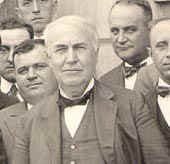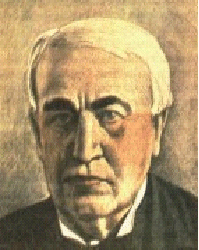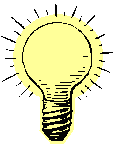|  Thomas
Alva Edison was an only child and his mother, a former school
teacher, taught him instead of sending him to school. Thomas loved to
read, especially about Science where he then learned many experiments. Thomas
Alva Edison was an only child and his mother, a former school
teacher, taught him instead of sending him to school. Thomas loved to
read, especially about Science where he then learned many experiments.
As a boy he had a
great deal of imagination and curiosity, and was taken away from school
because the teacher thought his non-stop questioning meant he was stupid.
His first interest was chemistry, he read all could about the subject
and he was only ten when he started growing vegetables, in the back
garden and selling them so he experimented with them in the garage.
At the age of twelve he worked selling magazines and fruit on a train
and starting printing a weekly newspaper on a printing press set up
in the luggage van, but one day one of his bottles of chemicals broke
and set fire to the van. He was kicked off the train and lost his job.
He also suffered an injury which made him partially deaf. The paper
was the first ever printed on a train.
 A station-master,
whose child saved he from an on-rushing train taught him Morse-code
and Edison became a telegraphist. He worked in a few different telegraph
offices in the United States and Canada. In 1869 he went to New York,
he had no friends there and was in debt, but he had the luck to walk
into a building of a telegraph company just as the telegraph stopped
walking. He was the only person there who could fix it, and after that
he was given a good job with the company. Soon afterwards he made loads
of money by selling his design for a telegraphic instrument called a
stock ticker which replayed information about share prices from the
markets. A station-master,
whose child saved he from an on-rushing train taught him Morse-code
and Edison became a telegraphist. He worked in a few different telegraph
offices in the United States and Canada. In 1869 he went to New York,
he had no friends there and was in debt, but he had the luck to walk
into a building of a telegraph company just as the telegraph stopped
walking. He was the only person there who could fix it, and after that
he was given a good job with the company. Soon afterwards he made loads
of money by selling his design for a telegraphic instrument called a
stock ticker which replayed information about share prices from the
markets.
Edison
developed a practical light bulb towards the end of 1879. In 1880, he
designed this version - the first to have all the essential features
of a modern light bulb - an incandescent filament in an evacuated glass
bulb with a screw bottom.
A
list of Edison's Inventions follows:
1868
• Invented the electrical vote recorder.
1869
• Invented the universal stock ticker.
1872
• Invented the "motograph".
• Invented the automatic telegraph system.
• Invented paraffin paper.
1875
• Discovered "Etheric Force," an electric phenomenon
that is the foundation of wireless telegraphy.
1876
• Invented the electric pen used for the first "mimeographs".
1877
• Invented the carbon telephone transmitter, making telephony
commercially practical. This included the microphone used in radio.
 1877 1877
• Invented the phonograph. This was Edison's favorite invention.
He sponsored the Edison Phonograph Polka to help make the new device
popular.
1879
• Discovered incandescent light.
• Radically improved dynamos and generators.
• Discovered a system of distribution, regulation, and measurement
of electric current-switches, fuses, sockets, and meters.
1880
• Invented the magnetic ore separator.
1885
• Discovered a system of wireless induction telegraph between
moving trains and stations. He also developed similar systems for ship-to-shore
use.
 1891 1891
• Invented the motion picture camera.
1896
• Invented the fluoroscope.
• Invented the fluorescent electric lamp.
1900
• Invented the nickel-iron-alkaline storage battery.
1914
• Invented the electric safety miner's lamp.
• Discovered the process for manufacturing synthetic carbolic
acid.
1915
• Conducted special experiments on more than 40 major war problems
for the Navy Department. Edison served as Chairman of the Naval Consulting
Board and did much other work on National Defence.
1927-1931
• Tested 17,000 plants for rubber content as a source of rubber
in war emergencies. A piece of vulcanized rubber was made from a strain
that he developed.
C.
A. , N. B. and R. G.
|


 Thomas
Alva Edison was an only child and his mother, a former school
teacher, taught him instead of sending him to school. Thomas loved to
read, especially about Science where he then learned many experiments.
Thomas
Alva Edison was an only child and his mother, a former school
teacher, taught him instead of sending him to school. Thomas loved to
read, especially about Science where he then learned many experiments. A station-master,
whose child saved he from an on-rushing train taught him Morse-code
and Edison became a telegraphist. He worked in a few different telegraph
offices in the United States and Canada. In 1869 he went to New York,
he had no friends there and was in debt, but he had the luck to walk
into a building of a telegraph company just as the telegraph stopped
walking. He was the only person there who could fix it, and after that
he was given a good job with the company. Soon afterwards he made loads
of money by selling his design for a telegraphic instrument called a
stock ticker which replayed information about share prices from the
markets.
A station-master,
whose child saved he from an on-rushing train taught him Morse-code
and Edison became a telegraphist. He worked in a few different telegraph
offices in the United States and Canada. In 1869 he went to New York,
he had no friends there and was in debt, but he had the luck to walk
into a building of a telegraph company just as the telegraph stopped
walking. He was the only person there who could fix it, and after that
he was given a good job with the company. Soon afterwards he made loads
of money by selling his design for a telegraphic instrument called a
stock ticker which replayed information about share prices from the
markets. 1877
1877 1891
1891